-
Chapter 2: NUMBER THEORY
Introduction
Highest common factor :
If there are three numbers like 10, 20, 30 and there exists numbers that can divide them to give remainder 0 viz. 5, 10. Then the lowest of those numbers is the HCF viz. 5
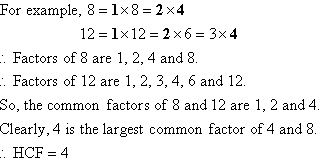
Least Common multiple:
If we take 4,6 as two numbers then both of them divide 12,
24, 36 etc fully giving remainder 0 so the lowest such
number common to both is the LCM which in this case is 12.
Method 1:

Method 2:
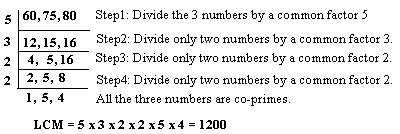
Q. What is the least number of cans needs for a vendor who has 21 L of Milk 'a' , 42 L of milk 'b' and 63L of Milk 'c'. If all cans should have same number of milk and he should need least number of cans.
Ans: Find HCF of 21, 42, 63 which is 21. So total cans are 6 i.e. 1 for milk 'a' , 2 for milk 'b' and 3 for milk 'c'.
Q. If the HCF and LCM of two numbers is 18, 180 and one of the number is 36. Then the second number is.
Ans. HCF * LCM = a * but HCF = 18, LCM = 180 and a= 36 so substituting we get b = 90.
Formulae of HCF and LCM
If a,b are consecutive even numbers their LCM is a*b/2;
HCF of fractions = HCF of numerator / LCM of denominator;
LCM of fractions = LCM of numerators / HCF of denominators;
Number of zeroes at the end of the factorial = n!
[ n/5 ] + [ n/5^2 ] + [ n/5^3 ] ....If a number "a" divides another number "b" exactly, we say that "a" is a factor of "b". In this case, "b" is called a multiple of "a".
Suppose we have to find the H.C.F. of three numbers. Then, H.C.F. of [(H.C.F. of any two) and (the third number)] gives the H.C.F. of three given numbers.
Product of two numbers = Product of their H.C.F. and L.C.M
Co-primes: Two numbers are said to be co-primes if their H.C.F. is 1
H.C.F. and L.C.M. of Fractions :
HCF = \( \frac{\text{H.C.F. of Numerators}}{\text{L.C.M. of Denominators}} \)
LCM = \( \frac{\text{L.C.M. of Numerators}}{\text{H.C.F. of Denominators}} \)
H.C.F. and L.C.M. of Decimal Fractions : In given numbers, make the same number of decimal places by annexing zeros in some numbers, if necessary. Considering these numbers without decimal point, find H.C.F. or L.C.M. as the case may be. Now, in the result, mark off as many decimal places as are there in each of the given numbers.
HCF of two consecutive even numbers is 2. HCF of two consecutive odd numbers is 1.
If the HCF of x and y is G, then the HCF of x, (x + y) is also G. x, (x - y) is also G
HCF of \( (a^m - 1) \text{ and } (a^n - 1) \text{ is given by } (a^{\text{HCF of } m,n} -1 ) \)
Strategy for Finding the GCD
Suppose you were required to find the HCF of 39, 78 and 195
The HCF of these numbers would necessarily have to be a factor (divisor) of the difference between any pair of numbers from the above 3. i.e. the HCF has to be a factor of (78 – 39 = 39) as well as of (195 – 39 = 156) and (195 – 78 = 117).
Usually select the two closest numbers to subtract. In above example use 78 and 39.
After subtraction, we get 39. The HCF of the given numbers 39, 78 , 195 will always be among the factors of 39.
The factors of 39 are 1,3,13,39.
Hence, one of these 4 numbers has to be the HCF of the numbers 39,78 and 195. Since we are trying to locate the Highest common factor we would begin our search from the highest number 39. In this case, 39 is the HCF.
Strategy for Finding LCM
Rules of Co-prime numbers :
Two consecutive natural numbers are always co-prime
Two consecutive odd numbers are always co-prime
Two prime numbers are always co-prime
One prime number and another composite number (such that the composite number is not a multiple of the prime number) are always co-prime (Examples: 17, 38; 23, 49 and so on, but note that 17 and 51 are not co-prime)
Three or more numbers being co-prime with each other means that all possible pairs of the numbers would be co-prime with each other. Thus, 47, 49, 51 and 52 are co-prime since each of the 6 pairs (47,49); (47,51); (47,52); (49,51); (49,52) and (51,52) are co-prime.
Three consecutive odd numbers are always co-prime
Three consecutive natural numbers with the first one being odd are coprime
Two consecutive natural numbers along-with the next odd number such that the first no. is even (examples: 22, 23, 25; 52, 53, 55; 68, 69, 71 and so on)
Three prime numbers (Examples: 17, 23, 29; 13, 31, 43 and so on)
Let us say that you were trying to find the LCM of 9,10,12 and 15. The rules of Co-prime numbers are beneficial for you !
Step 1 : If you can see a set of 2 or more co-prime numbers in the set of numbers for which you are finding the LCM write them down by multiplying them. So in the above situation, since we can see that 9 and 10 are co-prime to each other we can start off writing the LCM by writing 9 * 10 as the first step.
Step 2 : For each of the other numbers, consider what part of them have already been taken into the answer and what part remains outside the answer. In case you see any part of the other numbers such that it is not a part of the value of the LCM you are writing such a part would need to be taken into the answer of the LCM.
Thought about 12 : 12 is 2 * 2 * 3. 9 * 10 already has a 3 and one 2 in it prime factors. However, the number 12 has two 2's. This means that one of the two 2’s of the number 12 is still not accounted for in our answer. Hence, we need to modify the LCM by multiplying the existing 9 * 10 by a 2. With this change the LCM now becomes: 9 * 10 * 2
Thought bout 15 : 15 is 5 * 3, however the term 9 * 10 * 2 already has 5 and 3 . Hence there is no need for additionally having a 5 * 3 in the LCM. Hence, the LCM is 9 * 10 * 2.
Solved Questions
Ans .
35 – 1
- Explanation :
The HCF of (am – 1) and (a25 – 1) is given by (aHCF of m, n – 1) Thus, in this question the answer is: (35 – 1). Since 5 is the HCF of 35 and 125.]
Ans .
900
- Explanation :
The LCM of the given numbers is 180. Hence, all multiples of 180 would be divisible by all of these numbers. Checking the series 180, 360, 540, 720, 900 we can see that 900 is the first perfect square in the list. Option (a) is correct.
Ans .
980
- Explanation :
The prime numbers common to given numbers are 2,5 and 7. HCF = \( 2^2 * 5 * 7^2 = 980 \)
Ans .
true
- Explanation :
If two given numbers are divisible by a number, then their difference is also divisible by that number.
Ans .
170
- Explanation :
The required container has to measure both the tankers in a way that the count is an exact number of times. So its capacity must be an exact divisor of the capacities of both the tankers. Moreover, this capacity should be maximum. Thus, the maximum capacity of such a container will be the HCF of 850 and 680. The common factors of 850 and 680 are 2, 5 and 17. Thus, the HCF of 850 and 680 is 2 × 5 × 17 = 170. Therefore, maximum capacity of the required container is 170 litres. It will fill the first container in 5 and the second in 4 refill
Ans .
12240
- Explanation :
The distance covered by each one of them is required to be the same as well as minimum. The required minimum distance each should walk would be the lowest common multiple of the measures of their steps. Thus, we find the LCM of 80, 85 and 90. The LCM of 80, 85 and 90 is 12240. The required minimum distance is 12240 cm.
Ans .
151
- Explanation :
first find the LCM of 12, 16, 24 and 36. We get LCM = 2 × 2 × 2 × 2 × 3 × 3 = 144. 144 is the least number which when divided by the given numbers will leave remainder 0 in each case. But we need the least number that leaves remainder 7 in each case. Therefore, the required number is 7 more than 144. The required least number = 144 + 7 = 151.
Ans .
3
- Explanation :
Find the HCF of the weights. the maximum value of weight which can measure the weight of the fertiliser exact number of times is the HCF (75, 69) = 3.
Ans .
6930
- Explanation :
The minimum distance each should cover so that all can cover the distance in complete steps is LCM (63,70,77) = 6930.
Ans .
75
- Explanation :
longest tape which can measure the three dimensions of the room exactly is HCF (825,675,450) = 75 cm
Ans .
120
- Explanation :
smallest number which is exactly divisible by 6, 8 and 12 is LCM (6,8,12) = 24. So 24 * 3 = 120 is the smallest 3 digit number.
Ans .
960
- Explanation :
greatest 3-digit number exactly divisible by 8, 10 and 12 is multiple of the LCM (10,8,12) = 120. So 120 * 8 = 960 is the greatest 3 digit number.
Ans .
- Explanation :
Time they will change again is LCM of 48,72,108 i.e 432 = 7 min and 12 secs. So they will change again at 7:07:12 am
Ans .
31
- Explanation :
HCF of 403,434,465 = 31
Ans .
95
- Explanation :
LCM of 6,15,18 = 90. So answer is 90 + 5 = 95
Ans .
1152
- Explanation :
LCM of 18, 24, 32 = 288. So answer is 288 * 4 = 1152.
Ans .
36
- Explanation :
Sol. 108 = 2 2 x 3 3 , 288 = 2 5 x 3 2 and 360 = 23 x 5 x 32. H.C.F. = 2 2 x 3 2 = 36.
Ans .
27
- Explanation :
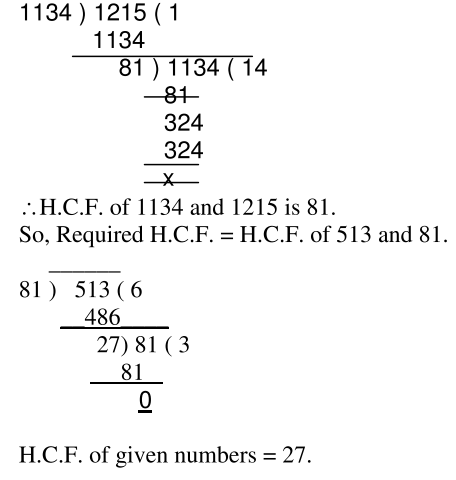
Ans .
17/29
- Explanation :
H.C.F. of 391 and 667 is 23. On dividing the numerator and denominator by 23, we get : \( \frac{391}{667} = \frac{17}{29} \)
Ans .
23 * 33 * 53 * 74 * 11
- Explanation :
L.C.M. = Product of highest powers of 2, 3, 5, 7 and 11 = 23 * 33 * 53 * 74 * 11
Ans .
37800
- Explanation :
\( 72 = 2^3 * 3^2 ; 108 = 3^3 * 2^2, 2100 = 2^2 * 5^2 * 3 * 7; LCM = 2^3 * 3^3 * 5^2 * 7 = 37800 \)
Ans .
432
- Explanation :
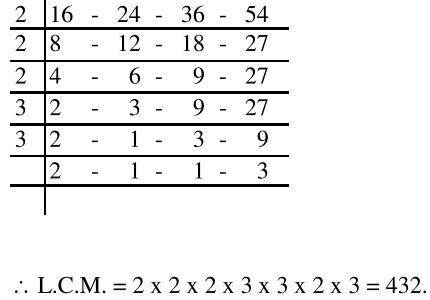
Ans .
2/81 and 80/3
- Explanation :
HCF of fractions = \( \frac{H.C.F. of 2,8,16,10}{L.C.M. of 3,9,81,27} = \frac{2}{81} \) and LCM of fractions = \( \frac{LCM of 2,8,16,10}{HCF. of 3,9,81,27} = \frac{80}{3} \)
Ans .
0.21 and 6.30
- Explanation :
Making the same number of decimal places, the given numbers are 0.63, 1.05 and 2.10. Without decimal places, these numbers are 63, 105 and 210. Now, H.C.F. of 63, 105 and 210 is 21. H.C.F. of 0.63, 1.05 and 2.1 is 0.21. L.C.M. of 63, 105 and 210 is 630. L.C.M. of 0.63, 1.05 and 2.1 is 6.30.
Ans .
195 and 143
- Explanation :
Let the required numbers be 15.x and llx. Then, their H.C.F. is x. So, x = 13. The numbers are (15 x 13 and 11 x 13) i.e., 195 and 143
Ans .
99
- Explanation :
other number = \( \frac{11 X 693}{77} = 99 \)
Ans .
45
- Explanation :
Required length = H.C.F. of 495 cm, 900 cm and 1665 cm. 495 = 32 x 5 x 11, 900 = 22 x 32 x 52 , 1665 = 32 x 5 x 37. H.C.F. = 32 x 5 = 45. Hence, required length = 45 cm.
Ans .
- Explanation :
Required number = H.C.F. of (1657 - 6) and (2037 - 5) = H.C.F. of 1651 and 2032. Required number = 127.
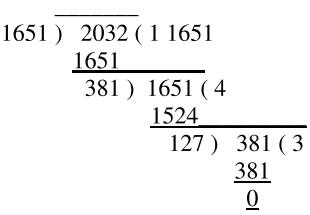
Ans .
35
- Explanation :
Required number = H.C.F. of (132 - 62), (237 - 132) and (237 - 62) = H.C.F. of 70, 105 and 175 = 35.
Ans .
540
- Explanation :
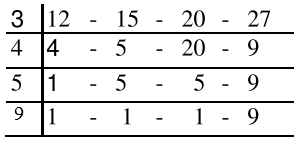
Ans .
505
- Explanation :
Required number = (L.C.M OF 6,7,8,9,12) + 1. L.C.M = 3 X 2 X 2 X 7 X 2 X 3 = 504. Hence required number = (504 +1) = 505.
Ans .
9720
- Explanation :
The Largest number of four digits is 9999. Required number must be divisible by L.C.M. of 12,15,18,27 i.e. 540. On dividing 9999 by 540,we get 279 as remainder . Required number = (9999-279) = 9720.
Ans .
10368
- Explanation :
Smallest number of five digits is 10000. Required number must be divisible by L.C.M. of 16,24,36,54 i.e 432, On dividing 10000 by 432,we get 64 as remainder. Required number = 10000 +( 432 – 64 ) = 10368.
Ans .
1394
- Explanation :
Here,(20-14) = 6,(25 – 19)=6,(35-29)=6 and (40-34)=6. Required number = (L.C.M. of 20,25,35,40) – 6 = 1394.
Ans .
1683
- Explanation :
L.C.M. of 5,6,7,8 = 840. Required number is of the form 840k + 3 Least value of k for which (840k + 3) is divisible by 9 is k = 2. Required number = (840 X 2 + 3) = 1683
Ans .
8:27:12
- Explanation :
Interval of change = (L.C.M of 48,72,108)sec.=432sec. So, the lights will agin change simultaneously after every 432 seconds i.e,7 min.12sec Hence , next simultaneous change will take place at 8:27:12 hrs
Ans .
31/36 , 17/18, 43/45, 59/60
- Explanation :
L.C.M. of 18,36,45 and 60 = 180. \( \frac{17}{18} = \frac{17 * 10}{18 * 10} = \frac{170}{180} \) and \( \frac{31}{36} = \frac{31*5}{36*5} = \frac{155}{180} \) , \( \frac{43}{45} = \frac{43*4}{45*4} = \frac{172}{180} \), \( \frac{59}{60} = \frac{59*3}{60*3} = \frac{177}{180} \). Comparing the numerators as all denominators are same we get the answer.
Quiz
Score more than 80% marks and move ahead else stay back and read again!